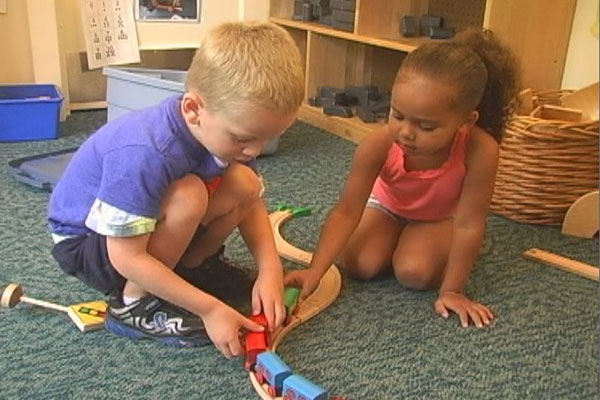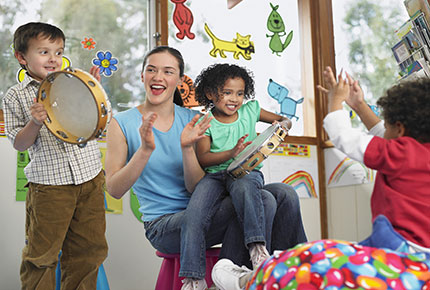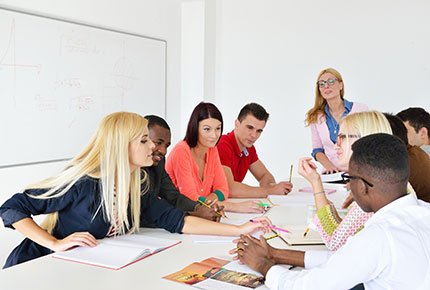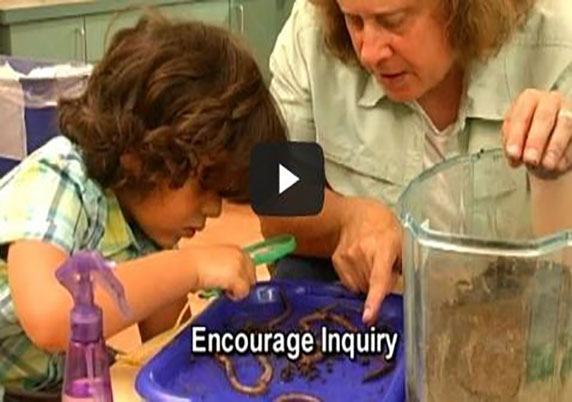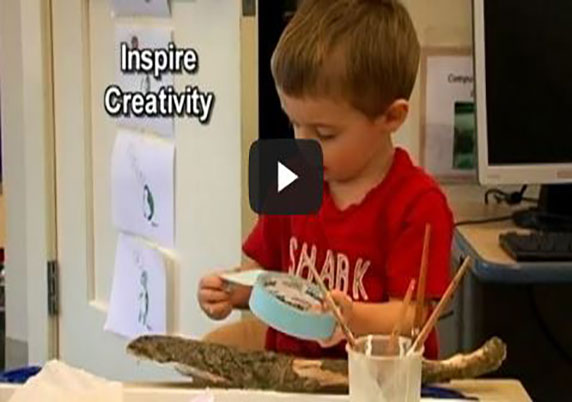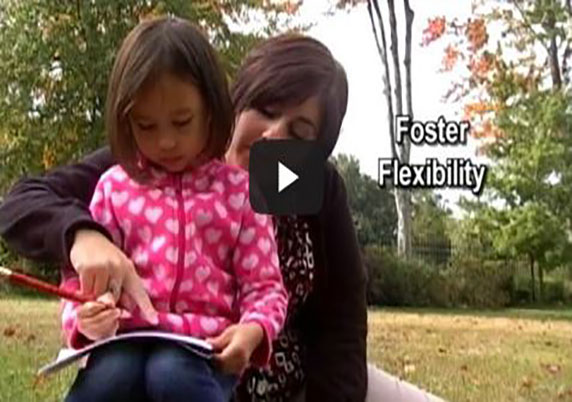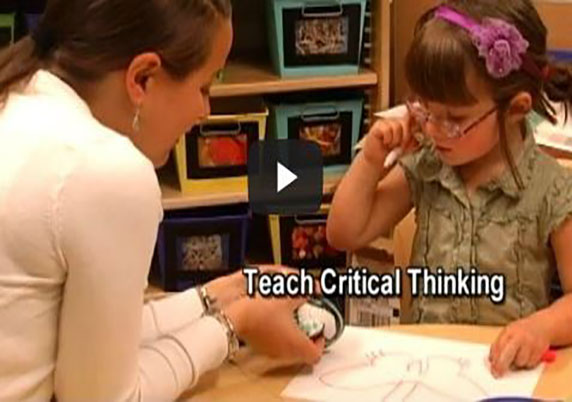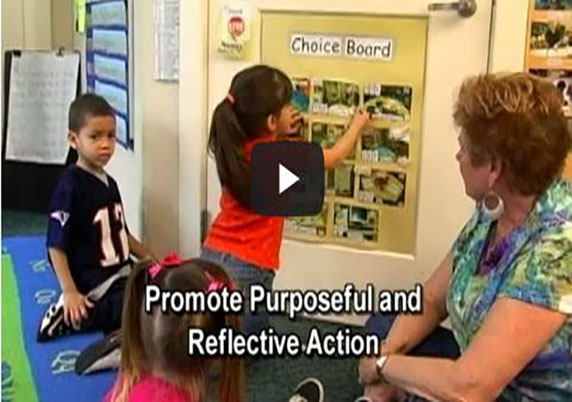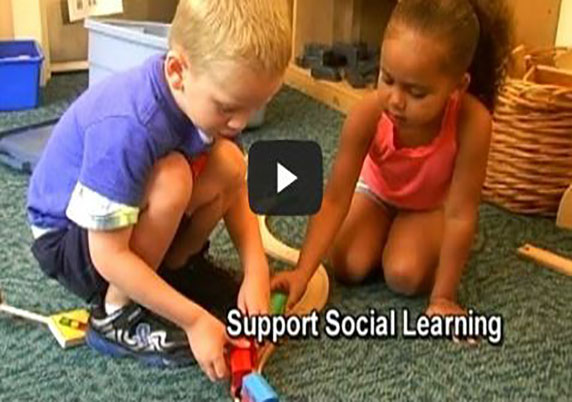Fostering Essential Dispositions in Young Children
Download a printable English transcript or Spanish transcript.
Narrator: Through early experiences, babies and young children begin to acquire the skills and knowledge they will need to be successful in life. It is also critical that they be supported in developing key characteristics that will help them to become competent learners.
Michelle Levy, CT Office of Early Childhood: As adults support children in acquiring new skills and new knowledge, it’s also important for them to think about the dispositions that children bring to learning: the ways that they engage in learning experiences with their environment and with the other people in their environment.
Narrator: The Connecticut Early Learning and Development Standards outline six “essential dispositions” that should be promoted in children. Adults can support all young children to be: Inquisitive, Creative, Flexible, Critical Thinkers, Purposeful and Reflective, and Social Learners.
Michelle Levy: There are many ways in which interactions that adults have with children can foster these dispositions. Adults can either support, or in some ways, dissuade children from furthering those dispositions, so hopefully they’re providing experiences and interacting with children in ways that help them further and use those dispositions and inclinations to learn more and to continue to learn over their lifetime.
Encourage Inquiry (1:47)
Amy Tyler, Preschool Teacher: Children are naturally inquisitive. We see this when children are manipulating different objects and seeing the effects of what they’re doing. They want to ask questions about different objects, and then they take it a step further and want to individually find the answers to those questions, and they do that by experimenting and exploring different materials. Teachers should create environments that are safe for the child to feel like they can explore and experiment with different things. When the boy filled up the cardboard container at the water table he really just was bringing it there to find out what would it do in the water.
Child: That was a bad idea.
Amy Tyler: You can just see the look on his face – like, “Oh, well why did that happen?” So I went over to just kind of prompt his thinking a little bit.
Amy: What do you think? What is this made out of?
Child: Cardboard.
Amy: Cardboard. And what happens to cardboard when it gets wet?
Child: It breaks.
Amy: It breaks.
Amy Tyler: Instead of answering a question for a child, it’s nice to see the child be interested in that answer and find that answer themselves.
Child: Noah! Guess what I made?
Amy: And in an environment where the child feels comfortable, they’ll be likely to do that.
Inspire Creativity (3:14)
Patricia Gardner, Preschool Teacher: I’d like to say that everybody is creative; everybody has the potential to be creative, but they have to be in the right situation in order for them to thrive. I give the children many opportunities to express themselves, to take risks, and experience different kinds of materials. We did an investigation on balls and we needed to build on some prior knowledge that the children had, so then we thought it would be exciting for us to give the children an opportunity to create their own games with balls. There was one little boy that spends a lot of time in blocks and that’s where he chose to be creative.
Child: In my game you got to try to roll it in, but you got to watch out because there’s a booby trap.
Patricia Gardner: It was evident how excited he was to take something that was familiar to him and give a different way of looking at these same materials. Our children have the opportunity to see how other people see things and gain different perspectives. We allow them – give them opportunities to find themselves, so to speak – but find something that they’re really, really good at and can express themselves and we support them.
Foster Flexibility (4:32)
Cynthia DeJesús, Preschool Teacher: Flexible children are children who are willing to try new things and engage in new activities in the classroom. It’s important to encourage flexibility in children because it allows them to take risks. It allows them to try new things, and with trying new things builds confidence.
Child: I can’t do it.
Cynthia: Let’s try it again with two cuts, ready?
Cynthia: Cut, cut, cut.
Cynthia: Here, we’ll do it together. Ready?
Child: Got it. We got it!
Cynthia: We got it together, now open it.
Cynthia DeJesús: I help children become more flexible when I provide safe environments that will allow them to explore.
Michelle Levy: We have routines that support children, for example, but allowing for some variation here and there to allow them to see that things can be flexible; you can think about things differently, look at things from a slightly different lens.
Teach Critical Thinking (5:37)
Amie Theriault, Toddler Teacher: I look at critical thinking just as with any other skills, something that needs to be developed. My goal is to really observe what they’re interested in throughout the day. I ask them open-ended questions and sometimes I also think aloud for them. I talk about what I’m noticing.
Amie: Look, it stuck to your shirt. What about the pompoms? Would the pompoms stick to your shirt? Try a pompom on your shirt. What happened?
Amie Theriault: I had a child who was doing a lot of observing and testing and problem solving, all because, you know, I had pointed out the paper on his shirt.
Amie: I wonder why that sticks to your shirt, but the pompom doesn’t?
Amie Theriault: Children are naturally scientific little beings and they want to know what’s happening in the world around them, so I think they’re very, very capable of using their background knowledge. When we as adults have high expectations, we provide materials and experiences for them that are very rich.
Amie: You’re thinking of a different way.
Amie Theriault: Their self-esteem goes up as they start seeing that they are capable of, you know, thinking deeply about things and solving problems.
Promote Purposeful and Reflective Action (7:02)
Amy Tyler: When children are purposeful in their activities they’re really focused on the details and they’re really thoughtful in what they’re doing, and they have this plan whether it’s in their head or on paper. We often plan for our day, whether it’s a question, “Where are you going to play, and what will you do there?” We often have them share with their peers, too. We make a lot of sketches and blueprints before building a structure, whether it’s independently or cooperatively.
Amy: Tell me about your picture that you’re making.
Child: Now this... we need to pick a color here of which straw we want.
Amy: (pointing at the picture) Oh this is the straw?
Child: Yeah.
Amy: (pointing at the picture) And what was this part again? What were you making?
Child: That’s the soda can.
Amy: A soda can.
Michelle Levy: It may not occur naturally for young children to really stop and be purposeful in their approach to an activity, to solving a problem. They may not take the time to pause and reflect on what they’ve done, but adults can model those behaviors; they can support children to develop those dispositions.
Amy: So now we have the yellow lemonade and the blue ice cubes.
Child: All done.
Amy: I think everything is in there. Everything from your blueprint is inside.
Support Social Learning (8:35)
Claudia Ahern, Preschool Teacher: Social learning is important because it’s the foundation which helps children be successful in school and then later in life. When children learn from their peers and they have positive interactions, they’re able to ask questions, they’re able to share toys, they’re able to say kind words to someone. There are many ways I scaffold children’s learning in the classroom.
Claudia: That’s interesting. Did you hear what Anthony said? If they take all that sand out and they put it on this side there won’t be any sand over there.
Claudia Ahern: Part of our curriculum is having children participate in cooperative groups and that’s a perfect opportunity for children to learn from each other.
Children: We need for the dinosaur with the eye on it. And we need this too. Here, this one also.
Michelle Levy: There’s a lot of focus today on supporting children to become college and career ready, and these essential dispositions are the building blocks and the foundations that set children up to be lifelong learners. It’s important that adults consider these dispositions in the ways they set up the environments for young children, in the way they interact with children as they are learning, and if they can support children in doing this and really think about their own dispositions, I think we have the potential for young children to be ready to engage in the 21st century, to move forward, and to continue learning.
Amy Tyler: Children are naturally inquisitive.
Patricia Gardner: I’d like to say that everybody is creative.
Cynthia DeJesús: Flexible children are willing to try new things.
Amie Theriault: Children are very capable of thinking critically.
Amy Tyler: Being purposeful and reflecting is so important.
Claudia Ahern: Social learning helps children be successful in school and then later in life.



